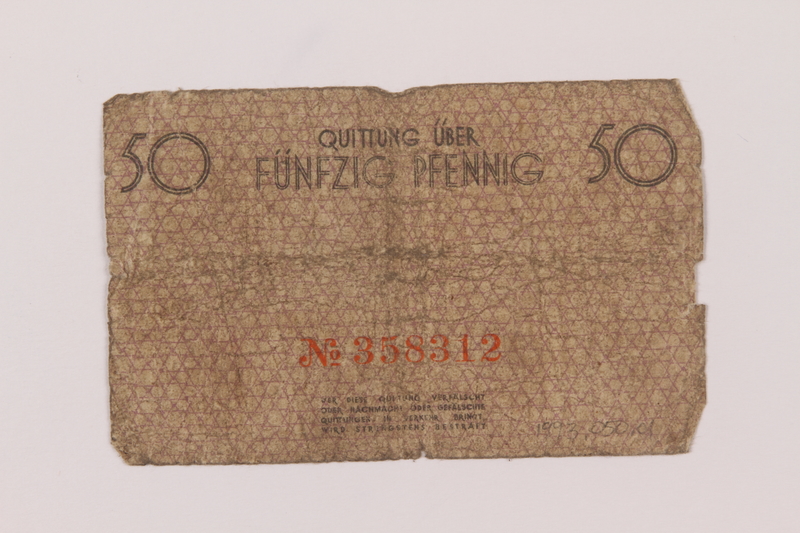Overview
- Brief Narrative
- 50 [funfzig] pfennig Łódź Ghetto receipt acquired by Raul Hilberg, a renowned scholar, who published the first comprehensive study of the Holocaust and initiated the academic study of the Holocaust. Hilberg and his parents fled Vienna, Austria, after its annexation by Germany in March 1938. Almost all of his family members in Europe were murdered during the Holocaust. Nazi Germany invaded Poland in September 1939. The Germans renamed it Litzmannstadt and confined the Jewish population to a ghetto. The Jewish Council was ordered to create a system of Quittungen [receipts] for use only in the ghetto. It was issued in 7 denominations: 50 pfenning, 1, 2, 5, 10, 20, 50, and 100 marks, and as coins, but there was little to exchange it for in the ghetto. In January 1942, half the residents were murdered at Chelmno killing center. In summer 1944, Łódź, the last ghetto in Poland, was destroyed and the remaining Jews were sent to Chelmno and Auschwitz-Birkenau killing centers.
- Date
-
issue:
1940 May 15
- Geography
-
issue:
Litzmannstadt-Getto (Łódź, Poland);
Łódź (Poland)
- Credit Line
- United States Holocaust Memorial Museum Collection, Gift of Raul Hilberg
- Markings
- face, lower left and upper right corners, purple ink : 50 / 50
face, black ink: QUITTUNG / ÜBER / 50 PFENNIG / DER AELTESTE DER JUDEN / IN LITZMANNSTADT / M. Rumkowski / LITZMANNSTADT , DEN 15 MAI 1940 [Receipt / about / 50 pennies / The Eldest of the Jews / in Litzmannstadt / M. Rumkowski / Litzmannstadt May 15, 1940]
back, left and right corner, black ink : 50
back, top center, black ink: QUITTUNG ÜBER / FÜNFZIG PFENNIG / WER DIESE QUITTUNG VERFÄLSCHT / ODER NACHMACHT ODER GEFÄLSCHTE / QUITTUNGEN IN VERKEHR BRINGT / WIRD STRENGSTENS BESTRAFT [ANYONE WHO FALSIFIES OR COPIES THIS RECEIPT, OR TRAFFICS IN COUNTERFEIT RECEIPTS, WILL BE STRICTLY PUNISHED]
back, center, red ink : Nº 358312 - Contributor
-
Subject:
Raul Hilberg
Issuer: Der Aelteste der Juden in Litzmannstadt
- Biography
-
Raul Hilberg was born on June 2, 1926, in Vienna, Austria, the only child of Jewish parents. His father Michael fought and was wounded in the First World War (1914-1918). In Vienna, he had a business selling household goods to people on installment plans. His parents attended synagogue occasionally. Raul was never religious, but he did attend a Zionist school. In March 1938, Nazi Germany annexed Austria and soon passed legislation to strip Jews of their rights as citizens. The family was ordered out of their apartment by gunpoint. His father was arrested during Kristallnacht, September 9-10 1938, but was soon released because he was a World War I veteran.
The family left Austria and after stopovers in France and Cuba, reached Brooklyn, NY, on September 1, 1939. Michael worked in a factory and Hilberg attended Lincoln High School. He enrolled in Brooklyn College until enlisting in the Army in 1944. He was deployed to Germany in 1945 with the 45th infantry division. He served with an Oklahoma division that liberated Dachau, but was not with the unit at the time. He was with the first troops that entered Munich. He was later assigned to the Army documentation division, which needed staff fluent in German. The war ended in May 1945. Nearly all the members of Hilberg's family on both his mother's and father's side were murdered during the Holocaust. Postwar, Hilberg assisted in the search for German documents to aid the prosecution at the war crimes trials. His unit was housed in the Nazi Party’s former offices in Munich. Crates containing Hitler’s personal library were stored there and Hilberg was fascinated by the contents. After his discharge, he returned to Brooklyn College and changed his major from chemistry to history and political science, graduating in 1948. He then focused on political science and international law and completed a master’s in public law in 1950 at Columbia University. He taught at Hunter College and then obtained a federal job in the War Documentation Project in Alexandria, Va., cataloging documents released from German archives, copying by hand material necessary to his own research. He received his doctorate from Columbia in 1955. His dissertation was on the Holocaust, which was not then a topic of academic study. His adviser, Franz Neumann, warned him that the subject would be detrimental to his career.
In 1956, he took a position at the University of Vermont. In 1961, his book, “The Destruction of the European Jews” was published. It was the first comprehensive study of the Holocaust and established the field of Holocaust studies. It was a methodical, evidentiary work detailing the systematic, bureaucratic process that led to the mass murder of Jews as a matter of routine. Rejected by five publishers, it was accepted by the small Quadrangle Company after a patron, Frank Petschek, a wealthy businesman who had fled German occupied Czechoslovakia in fall 1938, agreed to subsidize the print run and purchase 1300 copies for libraries. In 1974, Hilberg offered the first college-level course on the Holocaust. He expanded his original work to three volumes and published five more books on the topic, as well as a memoir. He retired from the University of Vermont in 1991, after thirty-five years.
Hilberg was dedicated to expanding the public understanding of the Holocaust. He was a key figure in the development and establishment of the United States Holocaust Memorial Museum, serving as an original member of the President’s Commission on the Holocaust (1978–79) and on the United States Holocaust Memorial Council from 1980 through 1988. In 2006, he received the Knight Commander’s Order of Merit in Germany, the highest award given to non-German citizens. Hilberg married Christine Hemenway in the 1950s. They had two children, and eventually divorced. In 1980, he married Gwendolyn Montgomery. Hilberg, 81, died of lung cancer in Williston, Vt., on August 4, 2007.
Physical Details
- Language
- German
- Classification
-
Exchange Media
- Category
-
Money
- Object Type
-
Scrip (aat)
- Genre/Form
- Money
- Physical Description
- Łódź ghetto scrip on offwhite rectangular paper printed with black and purple ink. The face has a background of interlocked Stars of David resembling barbed wire. The denomination 50 within a purple square is in the lower left and upper right corners. A Star of David within a purple square is in the upper left and lower right corners. In the center is a 7 branched menorah overlaid with the denomination 50 PFENNIG, with German text above and below. The back has a background of interlocked Stars of David resembling barbed wire with the denomination 50 in the upper corners. In the center is the denomination FUNFZIG PFENNIG, the serial number in red ink, and German text. The scrip is faded, extremely soiled and worn, with small edge tears and a slit along a central crease.
- Dimensions
- overall: Height: 2.125 inches (5.398 cm) | Width: 3.375 inches (8.573 cm)
- Materials
- overall : paper, ink
Rights & Restrictions
- Conditions on Access
- No restrictions on access
- Conditions on Use
- No restrictions on use
Keywords & Subjects
- Topical Term
- Holocaust, Jewish (1939-1945)--Economic conditions. Holocaust, Jewish (1939-1945)--Poland--Łódź--Money. Jewish ghettos--Economic aspects--Poland--Łódź. Tokens--Poland--Łódź. Jewish refugees--United States.
- Geographic Name
- Poland--History--Occupation, 1939-1945--Economic aspects. Litzmannstadt-Getto (Łódź, Poland)--Economic aspects. Łódź (Poland)
- Corporate Name
- Litzmannstadt-Getto (Łódź, Poland)
Administrative Notes
- Legal Status
- Permanent Collection
- Provenance
- The 50 pfennig note was donated to the United States Holocaust Memorial Museum in 1993 by Raul Hilberg.
- Funding Note
- The cataloging of this artifact has been supported by a grant from the Conference on Jewish Material Claims Against Germany.
- Record last modified:
- 2023-06-06 09:58:02
- This page:
- https://collections.ushmm.org/search/catalog/irn8272
Download & Licensing
In-Person Research
- By Appointment
- Request 21 Days in Advance of Visit
- Plan a Research Visit
- Request to See This Object
Contact Us
Also in Raul Hilberg collection
The collection consists of ten piece of Łódź Ghetto scrip, 2 commemorative stamps, and an envelope relating to the experiences of Dr. Raul Hilberg as a scholar of the Holocaust as well as one piece of Theresienstadt scrip given to him by Frank Petschek, who had to flee Czechoslovakia after its annexation by Germany in fall 1938.
Date: approximately 1943-1968
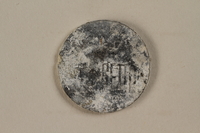
Łódź (Litzmannstadt) ghetto scrip, 5 mark coin
Object
5 mark Łódź Ghetto coin issued acquired by Raul Hilberg, a renowned scholar, who published the first comprehensive study of the Holocaust and initiated the academic study of the Holocaust. Hilberg and his parents fled Vienna, Austria, after its annexation by Germany in March 1938. Almost all of his family members in Europe were murdered during the Holocaust. Nazi Germany invaded Poland in September 1939. The Germans renamed it Litzmannstadt and confined the Jewish population to a ghetto. The Jewish Council was ordered to create a system of Quittungen [receipts] for use only in the ghetto. It was issued in 7 denominations: 50 pfenning, 1, 2, 5, 10, 20, 50, and 100 marks, and as coins, but there was little to exchange it for in the ghetto. In January 1942, half the residents were murdered at Chelmno killing center. In summer 1944, Łódź, the last ghetto in Poland, was destroyed and the remaining Jews were sent to Chelmno and Auschwitz-Birkenau killing centers.
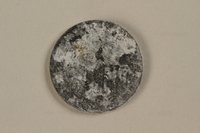
Łódź (Litzmannstadt) ghetto scrip, 5 mark coin
Object
5 mark Łódź Ghetto coin acquired by Raul Hilberg, a renowned scholar, who published the first comprehensive study of the Holocaust and initiated the academic study of the Holocaust. Hilberg and his parents fled Vienna, Austria, after its annexation by Germany in March 1938. Almost all of his family members in Europe were murdered during the Holocaust. Nazi Germany invaded Poland in September 1939. The Germans renamed it Litzmannstadt and confined the Jewish population to a ghetto. The Jewish Council was ordered to create a system of Quittungen [receipts] for use only in the ghetto. It was issued in 7 denominations: 50 pfenning, 1, 2, 5, 10, 20, 50, and 100 marks, and as coins, but there was little to exchange it for in the ghetto. In January 1942, half the residents were murdered at Chelmno killing center. In summer 1944, Łódź, the last ghetto in Poland, was destroyed and the remaining Jews were sent to Chelmno and Auschwitz-Birkenau killing centers.
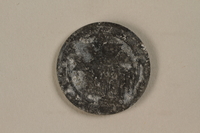
Łódź (Litzmannstadt) ghetto scrip, 5 mark coin
Object
5 mark Łódź Ghetto coin acquired by Raul Hilberg, a renowned scholar, who published the first comprehensive study of the Holocaust and initiated the academic study of the Holocaust. Hilberg and his parents fled Vienna, Austria, after its annexation by Germany in March 1938. Almost all of his family members in Europe were murdered during the Holocaust. Nazi Germany invaded Poland in September 1939. The Germans renamed it Litzmannstadt and confined the Jewish population to a ghetto. The Jewish Council was ordered to create a system of Quittungen [receipts] for use only in the ghetto. It was issued in 7 denominations: 50 pfenning, 1, 2, 5, 10, 20, 50, and 100 marks, and as coins, but there was little to exchange it for in the ghetto. In January 1942, half the residents were murdered at Chelmno killing center. In summer 1944, Łódź, the last ghetto in Poland, was destroyed and the remaining Jews were sent to Chelmno and Auschwitz-Birkenau killing centers.
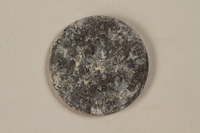
Łódź (Litzmannstadt) ghetto scrip, 10 mark coin
Object
10 mark Łódź Ghetto coin acquired by Raul Hilberg, a renowned scholar, who published the first comprehensive study of the Holocaust and initiated the academic study of the Holocaust. Hilberg and his parents fled Vienna, Austria, after its annexation by Germany in March 1938. Almost all of his family members in Europe were murdered during the Holocaust. Nazi Germany invaded Poland in September 1939. The Germans renamed it Litzmannstadt and confined the Jewish population to a ghetto. The Jewish Council was ordered to create a system of Quittungen [receipts] for use only in the ghetto. It was issued in 7 denominations: 50 pfenning, 1, 2, 5, 10, 20, 50, and 100 marks, and as coins, but there was little to exchange it for in the ghetto. In January 1942, half the residents were murdered at Chelmno killing center. In summer 1944, Łódź, the last ghetto in Poland, was destroyed and the remaining Jews were sent to Chelmno and Auschwitz-Birkenau killing centers.
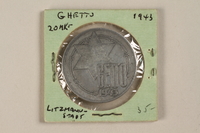
Łódź (Litzmannstadt) ghetto scrip, 20 mark coin
Object
20 mark Łódź Ghetto coin acquired by Raul Hilberg, a renowned scholar, who published the first comprehensive study of the Holocaust and initiated the academic study of the Holocaust. Hilberg and his parents fled Vienna, Austria, after its annexation by Germany in March 1938. Almost all of his family members in Europe were murdered during the Holocaust. Nazi Germany invaded Poland in September 1939. The Germans renamed it Litzmannstadt and confined the Jewish population to a ghetto. The Jewish Council was ordered to create a system of Quittungen [receipts] for use only in the ghetto. It was issued in 7 denominations: 50 pfenning, 1, 2, 5, 10, 20, 50, and 100 marks, and as coins, but there was little to exchange it for in the ghetto. In January 1942, half the residents were murdered at Chelmno killing center. In summer 1944, Łódź, the last ghetto in Poland, was destroyed and the remaining Jews were sent to Chelmno and Auschwitz-Birkenau killing centers.
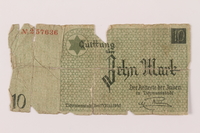
Łódź (Litzmannstadt) ghetto scrip, 10 mark note
Object
10 [zehn] mark Łódź Ghetto note acquired by Raul Hilberg, a renowned scholar, who published the first comprehensive study of the Holocaust and initiated the academic study of the Holocaust. Hilberg and his parents fled Vienna, Austria, after its annexation by Germany in March 1938. Almost all of his family members in Europe were murdered during the Holocaust. Nazi Germany invaded Poland in September 1939. The Germans renamed it Litzmannstadt and confined the Jewish population to a ghetto. The Jewish Council was ordered to create a system of Quittungen [receipts] for use only in the ghetto. It was issued in 7 denominations: 50 pfenning, 1, 2, 5, 10, 20, 50, and 100 marks, and as coins, but there was little to exchange it for in the ghetto. In January 1942, half the residents were murdered at Chelmno killing center. In summer 1944, Łódź, the last ghetto in Poland, was destroyed and the remaining Jews were sent to Chelmno and Auschwitz-Birkenau killing centers.
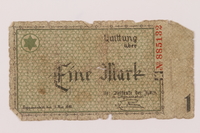
Łódź (Litzmannstadt) ghetto scrip, 1 mark note
Object
1 [eine] mark Łódź Ghetto note acquired by Raul Hilberg, a renowned scholar, who published the first comprehensive study of the Holocaust and initiated the academic study of the Holocaust. Hilberg and his parents fled Vienna, Austria, after its annexation by Germany in March 1938. Almost all of his family members in Europe were murdered during the Holocaust. Nazi Germany invaded Poland in September 1939. The Germans renamed it Litzmannstadt and confined the Jewish population to a ghetto. The Jewish Council was ordered to create a system of Quittungen [receipts] for use only in the ghetto. It was issued in 7 denominations: 50 pfenning, 1, 2, 5, 10, 20, 50, and 100 marks, and as coins, but there was little to exchange it for in the ghetto. In January 1942, half the residents were murdered at Chelmno killing center. In summer 1944, Łódź, the last ghetto in Poland, was destroyed and the remaining Jews were sent to Chelmno and Auschwitz-Birkenau killing centers.
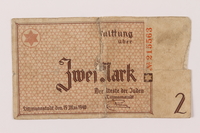
Łódź (Litzmannstadt) ghetto scrip, 2 mark note
Object
2 [zwei] mark Łódź Ghetto note acquired by Raul Hilberg, a renowned scholar, who published the first comprehensive study of the Holocaust and initiated the academic study of the Holocaust. Hilberg and his parents fled Vienna, Austria, after its annexation by Germany in March 1938. Almost all of his family members in Europe were murdered during the Holocaust. Nazi Germany invaded Poland in September 1939. The Germans renamed it Litzmannstadt and confined the Jewish population to a ghetto. The Jewish Council was ordered to create a system of Quittungen [receipts] for use only in the ghetto. It was issued in 7 denominations: 50 pfenning, 1, 2, 5, 10, 20, 50, and 100 marks, and as coins, but there was little to exchange it for in the ghetto. In January 1942, half the residents were murdered at Chelmno killing center. In summer 1944, Łódź, the last ghetto in Poland, was destroyed and the remaining Jews were sent to Chelmno and Auschwitz-Birkenau killing centers.
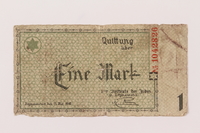
Łódź (Litzmannstadt) ghetto scrip, 1 mark note
Object
1 [eine] mark Łódź Ghetto note acquired by Raul Hilberg, a renowned scholar, who published the first comprehensive study of the Holocaust and initiated the academic study of the Holocaust. Hilberg and his parents fled Vienna, Austria, after its annexation by Germany in March 1938. Almost all of his family members in Europe were murdered during the Holocaust. Nazi Germany invaded Poland in September 1939. The Germans renamed it Litzmannstadt and confined the Jewish population to a ghetto. The Jewish Council was ordered to create a system of Quittungen [receipts] for use only in the ghetto. It was issued in 7 denominations: 50 pfenning, 1, 2, 5, 10, 20, 50, and 100 marks, and as coins, but there was little to exchange it for in the ghetto. In January 1942, half the residents were murdered at Chelmno killing center. In summer 1944, Łódź, the last ghetto in Poland, was destroyed and the remaining Jews were sent to Chelmno and Auschwitz-Birkenau killing centers.
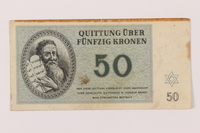
Theresienstadt ghetto-labor camp scrip, 50 kronen note, acquired by Czech refugee
Object
50 (funfzig) mark Theresienstadt ghetto-labor camp note given to Raul Hilberg by Frank Petschek, who, with his wife, as well as the extended Petschek family, had to flee Czechoslovakia after its annexation by Nazi Germany in fall 1938. After the war, the confiscation of the Petschek family's vast business and land holdings by the Nazi regime were used for a major case in the War Criminals trials at Nuremberg. Hilberg and his parents fled Vienna, Austria, after its annexation by Germany in March 1938. It was Petschek's generosity that made possible the publication of Hilberg's landmark work, Destruction of the European Jews, in 1961, a foundational and authoritative study of the Holocaust. The scrip was issued in Theresienstadt in German occupied Czechoslovakia beginning in May 1943. Inmates were not allowed to have currency and the SS ordered the Jewish Council to design scrip for use only in the camp. It was issued to create a false appearance of normalcy and as an incentive for forced labor. There was little to obtain with the scrip. Notes were printed in 7 denominations: 1, 2, 5, 10, 20, 50, 100. The camp was in operation from November 24, 1941, until early May 1945. Approximately 140,000 Jewish men, women, and children were transferred to Theresienstadt; nearly 90,000 were then deported, likely to their death further east. About 33,000 Jews died in Theresienstadt.
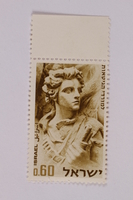
Israeli postage stamp commemorating the Warsaw ghetto uprising
Object
Postage stamp issued April 24, 1968, in Israel acquired by Dr. Raul Hilberg. The stamp commemorates the 25th anniversary of the Warsaw ghetto uprisin. It depicts a Jewish fighter, based on a detail of the bronze sculpture by Nathan Rapoport memorializing the rebels, which stands in Warsaw. On April 19, 1943, Jewish fighters in the ghetto made their final stand against German troops sent to deport the last of the ghetto’s population to the death camps. The rebels managed to fight back for four weeks as the Germans resorted to burning down the ghetto building by building. Hilberg was a renowned scholar who published the first comprehensive study of the Holocaust and initiated the academic study of the Holocaust. Hilberg and his parents fled Vienna, Austria, after its annexation by Germany in March 1938. Almost all of his family members in Europe were murdered during the Holocaust.
First day cover stamp and envelope issued to commemorate Treblinka
Object
First day cover postcard and envelope acquired by Raul Hilberg of the stamp issued to commemorate Treblinka killing center by the German Democratic Republic in 1963. This was the first stamp of a series issued annually by the DDR under the name Mahn- und Gedensksatte [Remembrance and Memorial Center] in honor of World War II (1939-1945). In July 1942, the Germans built Treblinka II, a killing center, near the village of Wolka Okraglik, Poland, about 50 miles north of Warsaw. Nearly 1 million Jews were killed at Treblinka II before it was closed in the fall of 1943. As Soviet troops moved into the area in late July 1944, camp authorities shot the remaining prisoners and evacuated the camp. Hilberg was a renowned scholar who published the first comprehensive study of the Holocaust and initiated the academic study of the Holocaust. He and his parents fled Vienna, Austria, after its annexation by Germany in March 1938. Almost all of his family members in Europe were murdered during the Holocaust.


